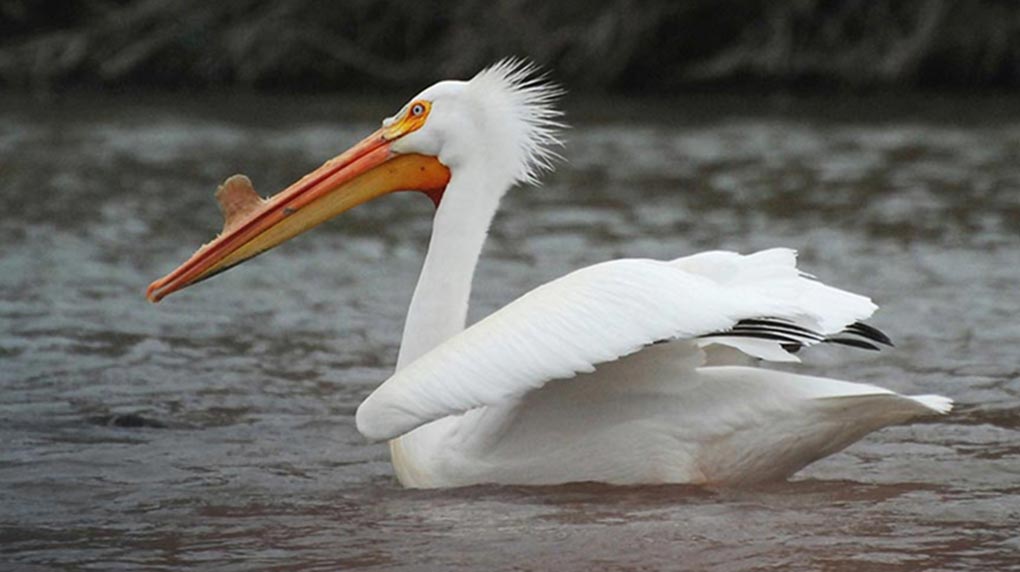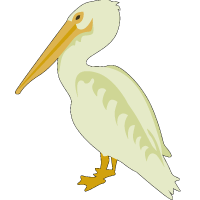American White Pelican

Introduction
This chapter provides a review of progress toward protection and recovery of American White Pelican in Ontario from 2007 to 2015.
Species information
American White Pelican (Pelecanus erythrorhynchos) is a very large, white bird with black flight feathers at the edge of its wings and orange webbed feet. This species has a wingspan of up to 3 metres and weighs between 5 and 9 kilograms. American White Pelican is most noted for its size and its long yellow-orange pouched bill.
In Ontario, American White Pelican breeds primarily in two locations: Lake of the Woods and Lake Nipigon. The species has been known to breed in other locations, such as the north shore of Lake Superior; however, there are generally fewer nests at these locations. In the summer of 2016, the species was observed nesting on two islands in Lake Erie. The species nests in groups on sparsely-treed islands in large lakes, rivers or reservoirs with an adequate source of prey. It uses several types of environments for foraging, including rivers, lakes, marshes and estuaries.
American White Pelican faces several threats to its survival and recovery, including the potential for outbreaks of disease, flooding or predation of nests, pollution and human disturbance. American White Pelicans are very sensitive to human disturbance, especially during nesting and fledging. Even unintentional disturbances may cause adult birds to temporarily leave or abandon their nests, making chicks vulnerable to overheating and predation.
The survival and recovery of American White Pelican is influenced by other factors as well. Because American White Pelican is a colonially nesting species (nests in large groups), threats to the species may impact a large number of birds at once and therefore pose a greater risk to the species than if its nest sites were less concentrated. Negative events could include disease outbreaks, pollution, flooding and disturbances by humans.
American White Pelican is listed as threatened at the provincial level (Species at Risk in Ontario List) and is not listed at the federal level. Globally, it is considered to be apparently secure.
Provincial status
The American White Pelican was regulated under the previous Endangered Species Act and has been listed as endangered since 1977. Under the Endangered Species Act, 2007 (ESA or "the Act"), American White Pelican retained its status as endangered. The Committee on the Status of Species at Risk in Ontario (COSSARO) then re-assessed American White Pelican as threatened as the population was stable or increasing during the time of assessment. The status of the species was altered on the Species at Risk in Ontario List in 2009. In future assessments, COSSARO may consider information gained through protection and recovery actions regarding the species' threats and trends in population and distribution.
Species and habitat protection
Protecting American White Pelican and its habitat are key components in the implementation of the ESA, and continue to be government-led actions, as identified in the government response statement. As a species that was regulated under the previous Endangered Species Act, American White Pelican has received species and habitat protection since 1977. American White Pelican retained these protections under the ESA, which prohibits the species from being killed, harmed, harassed, captured or taken and protects its habitat from being damaged or destroyed. Habitat protection for the species was initially based on the general habitat definition in the Act; however, habitat protection for the species is now based on a habitat regulation that came into force in 2012. American White Pelican in Ontario also receives protection as a Specially Protected Bird under Schedule of the Fish and Wildlife Conservation Act, 1997 (FWCA) (e.g., no hunting/trapping, approvals required for buying/selling, etc.). In addition, all nests and eggs of birds are generally protected under section 7 of the FWCA.
The government developed the habitat regulation (Ontario Regulation 242/08, section 24.0.1) for American White Pelican within the timeframe required by the ESA. The habitat regulation provides clarity to the public and others on what areas are protected as American White Pelican habitat. The regulated habitat includes areas that are required by the species to carry out its life processes (e.g., nesting) within its range in Ontario. The habitat regulation was developed based on information regarding the habitat needs of the species as well as social and economic factors, collected from a variety of sources including comments received through public consultation. Any person who negatively impacts American White Pelican or its habitat without prior authorization may be prosecuted under the ESA.
American White Pelican has received species and habitat protection since 1977. American White Pelican retained these protections under the ESA, which prohibits the species from being killed, harmed, harassed, captured or taken and protects its habitat from being damaged or destroyed. Habitat protection for the species was initially based on the general habitat definition in the Act; however, habitat protection for the species is now based on a habitat regulation that came into force in 2012.
In addition, the habitat of American White Pelican is currently protected from being damaged or destroyed under the ESA. Habitat protection was initially based on the general habitat definition in the ESA. The habitat of American White Pelican is now protected through a habitat regulation that came into force in 2012.
Recovery strategy
A recovery strategy for American White Pelican was published on February 18, 2011, which was within the timeframe required by the ESA. Recovery strategies are advice to government and represent the best available scientific knowledge. The strategy identifies American White Pelican habitat needs and the threats that it faces, while recommending objectives and approaches for protecting and recovering the species. The recovery strategy also includes recommendations on the areas of habitat to be considered in the development of a habitat regulation.
Government response statement
The Ministry of Natural Resources and Forestry ("the Ministry") published the government response statement (GRS) for American White Pelican on November 18, 2011, which was within the timeframe required by the ESA. The GRS is government policy that contains the Government of Ontario’s goal for the recovery of American White Pelican.
To help achieve this goal, the government leads and supports recovery actions identified in the GRS. Common actions for the government to lead as it works toward achieving a species' recovery goal are provided in section 2.5 of the Species at Risk Program Status (2008 - 2015). One specific action for the government to lead to help protect and recover American White Pelican is:
Recovery Goal
The government’s goal for the recovery of the American White Pelican is to maintain, and allow for the natural increase of, successfully breeding American White Pelicans and colonies in Ontario while minimizing threats to their recovery.
- Ensure appropriate timing windows for activities undertaken in and around American White Pelican habitat are considered in the application of the ESA.
The GRS for American White Pelican also lists six actions the Ministry supports others to undertake for the species. These government-supported actions fall under the objectives identified in the GRS, which are:
- Assess changes in the distribution, abundance, and health of American White Pelicans;
- Improve knowledge of American White Pelican habitat, ecology, and threats; and
- Raise awareness and promote stewardship of American White Pelicans in Ontario.
Government funded projects
An important government-led action in the GRS for American White Pelican is to support partners to undertake activities to protect and recover the species. Through the Species at Risk Stewardship Fund the Ministry has supported a total of four projects ($90,148) designed to contribute to the protection and recovery of American White Pelican. All of these projects targeted multiple species at risk, including American White Pelican, and partners reported that they were successful in securing additional funding ($60,058) from other sources. This amount includes additional funding and in-kind support in the form of time and expertise provided by volunteers.
Stewardship partners reported that provincial funding helped them to secure in-kind support by involving 71 individuals who volunteered 1,372 hours of their time toward protection and recovery activities for multiple species at risk, including American White Pelican, which has an estimated value of $39,500. In addition, the partners reported providing outreach on multiple species at risk, including American White Pelican, to 47 individuals.
The remainder of this section highlights two of the projects that were supported through the Species at Risk Stewardship Fund and their corresponding government-supported recovery actions. Both of these projects supported the high priority GRS action to develop and provide information to landowners, land managers, and the fishing community to increase awareness and promote the protection and recovery of American White Pelican.
Pinegrove Productions, developed a series of multi-media educational resources under their ongoing "Our Incredible World" project, including materials focused specifically on American White Pelican. The objectives of the project are to educate youth about biodiversity and species at risk through games, videos, fact sheets and e-newsletters. This project also included the development of a website series called "Kids Can" which features stories of environmental stewardship activities undertaken by youth in Ontario and Canada. Announcements regarding the curriculum-linked classroom resources were shared with Ontario school boards, teachers, local naturalist clubs and other agencies through press releases and advertisements in magazines marketed to environmental educators. The resources, which are available at no charge on the Our Incredible World website, are being used by public libraries and school boards across Ontario, as well as school boards in other Canadian provinces.
The Lake Huron Centre for Coastal Conservation, trained volunteers under the Coast Watchers Program to be able to identify and report incidental observations of species at risk, including American White Pelican. This project supports the GRS action to provide information to landowners to increase awareness and promote protection and recovery of American White Pelican by communicating information about species at risk and engaging shoreline residents in issues affecting lake habitats. Nine residents along the Lake Huron shoreline volunteered to participate in this multi-year project as citizen scientists. Each volunteer was assigned responsibility for collecting and reporting information about a specific beach using standardized protocols throughout the spring, summer and fall seasons. The volunteers were trained to observe the coast, record shoreline and weather conditions, and categorize and quantify shoreline debris and wildlife mortalities. They also attended two webinar presentations on species at risk which were offered through a partnership between the Lake Huron Centre for Coastal Conservation and Ontario Nature. There were nine study locations in total, and they were fairly evenly distributed along the eastern Lake Huron shoreline, including Manitoulin Island and Tobermory in the north, Sarnia in the south and Balm Beach on the Georgian Bay shoreline (west of Midland). Although the location of this project was peripheral to the current distribution of American White Pelican colonies in Ontario, the provincial distribution of this recovering species is expanding, as indicated by recent observations of the species in Lake Erie, and American White Pelican was specifically listed as a species of interest for this project. This project is a great example of work that has raised awareness of species at risk in coastal environments of the Great Lakes and engaged citizens in stewardship of local beaches.
Species at Risk Stewardship Fund
-
 $0
$0for American White pelican exclusively
-
 $90,148
$90,148for multi-species projects that included American White Pelican
-
 $60,058
$60,058in additional funding and in-kind support
-
 4
4projects included the white pelican
-
 71
71volunteers
-
 1,372
1,372volunteer hours
-
 47
47people received outreach
Efforts to minimize adverse effects on American White Pelican
-
1protection or recovery permit
-
4registrations
Supporting partners through permits and their associated conditions, is an important government-led action. To date, one permit under section 17(2)(b) of the Act ('protection or recovery') has been issued for American White Pelican. This permit enabled research that supported progress on developing and implementing a standardized surveying and monitoring protocol for American White Pelican colonies. The authorized activities included gathering information on the breeding biology and ecology of one Lake Nipigon colony, including mapping the colony and its nest locations, counting and measuring eggs and collecting samples from individual birds to study their diet, reproductive health and levels of contamination. Studies also included collection of any dead individuals found during the site visits and performing necropsies to determine the cause of death. The permit required the minimization of adverse effects on members of the species through conditions such as: following the Animal Care Protocol for the species, release of any captured individuals at the point of capture and the immediate transportation to a member of the College of Veterinarians of Ontario if any American White Pelicans were injured or required care. The schedule for site visits was planned to maximize the amount of data collected while minimizing the disturbance to the colony.
Under the 'Wind facilities' section (section 23.20) of Ontario Regulation 242/08 under the ESA, four activities that may affect American White Pelican or its habitat have been registered. These registrations require the registered individual to comply with all conditions of the regulation, such as:
- Prepare and follow a mitigation plan; and
- Implement reasonable measures in the wind facility to avoid the killing, harming or harassing of members of the species such as, adjusting the blades or cut-in speed of wind turbines and periodically shutting the turbines down during times of day or of the year when the risk of killing, harming or harassing the species is highest.
Occurrences of American White Pelican in Ontario
Natural Heritage Information Centre (NHIC)
Fourteen populations
121 Observations of this species were submitted to the NHIC since 2008
Since 2008, when American White Pelican became protected under the ESA, the Ministry has received approximately 121 records of the species. These records are based on observations between 1957 and 2016 and come from a variety of sources.
Records submitted have helped to redefine where the species is known and has been known to occur and have provided additional information on the species' habitat and threats. Observation data has helped to identify seven new populations. These populations are located in Lake of the Woods, Lake Nipigon, Lac Seul, two locations in Lake Superior and two locations in Lake Erie. In addition, the viability of the Ombabika Narrows population in Lake Nipigon has been reassessed based on records submitted to the NHIC. The population’s viability was changed from poor to good or fair after the number of nests observed at the site increased from 14 in 1992 to 133 in 2009. It is possible that there are observations of American White Pelican that have not been submitted to the Ministry. Encouraging the submission of observations of American White Pelican to the Ministry is included in the GRS as a government-led action.
Ministry staff in Nipigon, Thunder Bay, Kenora and Sioux Lookout districts monitor breeding colonies to assess changes in the distribution, abundance, and health of American White Pelicans. Some colonies have been monitored since the 1970s (e.g., the colony at the Three Sisters Islands in Lake of the Woods), as the species has been listed as endangered since 1977. For example, the Thunder Bay District of the Ministry conducted an aerial survey in 2009 and a ground survey in 2011 for the Granite Island population of the species in Lake Superior. Everyone is encouraged, or may be required by an authorization or approval, to submit observations of the American White Pelican, as well as every other species at risk, to the Ministry’s Natural Heritage Information Centre for incorporation into the provincial record of observations.
Monitoring of American White Pelican breeding attempts at Lac Seul
In 2009, Ministry staff in Sioux Lookout District received a report of attempted breeding by American White Pelican on the Cormorant Islands in Lac Seul from a local tourism operator. Although American White Pelican had previously been observed foraging in the area, there had been no documented breeding attempts. Ministry staff in Sioux Lookout District have conducted annual monitoring of American White Pelican on the Cormorant Islands in Lac Seul since the population was first identified. Methods that minimize disturbance of the pelicans were used to collect data, including analysis of aerial photos taken during brief fixed-wing flights and over 10,000 trail camera photos taken during one breeding season. Monitoring records indicate that while breeding attempts have produced viable offspring during the past five breeding seasons (2011 to 2015), the Lac Seul colony is threatened by deterioration of nesting habitat. Further monitoring is required to investigate the potential suitability of other islands in Lac Seul or surrounding lakes where observations of the species have been reported.
Summary of progress towards meeting the recovery goal
Summary of progress
Progress has been made toward all government-led actions outlined in the GRS for American White Pelican. The Government of Ontario has directly undertaken actions to:
- Encourage submission of American White Pelican data to the Natural Heritage Information Centre;
- Protect the species and its habitat through the ESA;
- Develop and enforce a regulation identifying the specific habitat of the species;
- Support partners to undertake activities to protect and recover the species;
- Establish and communicate annual priority actions for support;
- Educate other agencies and planning authorities on the requirement to consider the protection of the species and its habitat; and
- Undertake communications and outreach to increase public awareness of species at risk in Ontario.
Government-supported actions are organized under over-arching recovery objectives. Progress has been made toward all of the government-supported recovery objectives and several of the associated actions.
Under the objective to assess changes in the distribution, abundance, and health of American White Pelicans, considerable progress has been made toward this high priority action:
- Develop and implement a standardized survey and monitoring protocol for American White Pelican colonies to assess the distribution and abundance of the colonies, quantify reproductive success of colonies in relation to other North American colonies, and detect changes in health as a result of disease or environmental contamination (Action No. 1; High Priority).
Although a standardized protocol has not been developed, the action associated with monitoring has been implemented by Ministry staff in Sioux Lookout, Nipigon, and Thunder Bay districts and a 'protection and recovery permit' that was issued for research conducted in Nipigon district.
Under the objective to improve knowledge of American White Pelican habitat, ecology, and threats, progress has been made toward three of the four actions:
- Evaluate existing colonies to improve understanding of what level of tolerance American White Pelicans have for human disturbances adjacent to their breeding colonies (Action No. 2; High Priority);
- Compile existing habitat data from across the province to better understand American White Pelican habitat use, selection, and to target survey efforts (Action No. 3); and
- Conduct research to gain a better understanding of the dietary preferences and diseases associated with fish consumption (Action No. 5).
The first two of the three actions above have been implemented through monitoring activities conducted by the Ministry and the third action has been implemented through a 'protection and recovery permit'.
Under the objective to raise awareness and promote stewardship of American White Pelicans in Ontario, progress has been made toward the action:
- Develop and provide information to landowners, land managers and the fishing community to increase awareness and promote protection and recovery of the American White Pelican (Action No. 6; High Priority).
The action has been implemented through several projects supported by the Species at Risk Stewardship Fund and conditions of authorizations.
The recovery goal for American White Pelican is to maintain, and allow for the natural increase of, successfully breeding American White Pelicans and colonies in Ontario while minimizing threats to their recovery. Effort made toward the government-led and government-supported GRS actions has helped to make progress toward this goal. For example, consistent with minimizing threats to their recovery, survey and monitoring work was conducted using methods that minimize human disturbance. Minimizing human disturbance is done with the intention of avoiding the possibility of an individual abandoning its nest, which exposes eggs and chicks to over-heating or predation. The monitoring data from aerial photos and trail cameras, and data from observations and specimens collected by researchers provide valuable insight to the causes of unsuccessful breeding attempts and changes to habitat conditions. In addition, the provincial record of observations indicates that American White Pelican in Ontario is exhibiting trends that are consistent with the aspect of the GRS recovery goal to maintain and allow for the natural increase of successfully breeding American White Pelicans. Since 2008: seven new populations were added to the provincial record of observations, including the population at Granite Island in Black Bay of Lake Superior which was identified based on observations made prior to 2008; the estimated viability of the population at Ombabika Narrows improved; and there were no changes to the estimated viability of the other populations. Although the new populations may be the result of increased search effort or reporting of observations and therefore may not represent increases to the total provincial population, knowing the location of all populations of the species is critical to ensuring that they are protected and conserved.
Recommendations
As stated in the GRS, the review of progress toward protecting and recovering American White Pelican can be used to help identify whether adjustments are needed to achieve the protection and recovery of the species. Based on progress to-date, the overall direction provided in the GRS for American White Pelican should continue to guide protection and recovery actions for the species, particularly for those actions identified as high priority in the GRS. Relative to actions that have received a high level of support, the following actions have received support to a lesser degree and may be considered in future decisions regarding the protection and recovery of American White Pelican:
- While progress has been made to improve understanding of the level of tolerance American White Pelicans have for human disturbances through the installation of trail cameras and other monitoring work, further analysis of the information collected is required in to fully evaluate existing colonies to improve understanding of what level of tolerance American White Pelicans have for human disturbances adjacent to their breeding colonies (Action No. 2; High Priority).
- While stewardship projects designed to raise public awareness of multiple species at risk, including American White Pelican, have supported implementation of the GRS action to develop and provide information to landowners, land managers, and the fishing community to increase awareness and promote protection and recovery of the American White Pelican (Action No. 6; High Priority), to fully implement the action it would be beneficial to target delivery of information that is specific to the protection and recovery of American White Pelican (e.g., the importance of avoiding disturbances during the breeding season) to landowners, land managers, and the fishing community.
- Actions for which progress has been limited should be supported in future implementation planning, such as determining what effects current water level management and natural water levels may be having on American White Pelicans (Action No. 4).
Moving forward, protecting and recovering American White Pelican will continue to be a shared responsibility that will require the involvement of many individuals, organizations and communities. Financial support for the implementation of actions may be available through the Species at Risk Stewardship Fund or the Species at Risk Research Fund for Ontario. The Ministry can also advise if any authorizations under the ESA or other legislation may be required to undertake a project. By working together, progress can continue to be made toward protecting and recovering American White Pelican in Ontario.
Summary of progress toward the protection and recovery of American White Pelican (2007 to 2015)
Provincial status:
- American White Pelican is classified as threatened under the Endangered Species Act, 2007 (ESA). It was listed as endangered under the previous Endangered Species Act and retained this status in 2008 when the ESA came into force. American White Pelican was re-assessed as threatened, and its status was updated on the Species at Risk in Ontario List in 2009. American White Pelican has received species and habitat protection since 1977. Habitat protection for the species is now based on a habitat regulation that came into force in 2012.
Species-specific documents and guidance published by the government:
- Recovery Strategy for American White Pelican (2011)
- American White Pelican: Ontario Government Response Statement (2011)
- American White Pelican Habitat Regulation: Ontario Regulation 242/08 (2012)
Government-supported stewardship projects:
- Through the Species at Risk Stewardship Fund, the Ministry of Natural Resources and Forestry ("the Ministry") has enabled its stewardship partners to conduct a total of four projects ($90,148) that have supported the protection and recovery of multiple species at risk, including American White Pelican.
- The Ministry’s support helped its stewardship partners to involve 71 individuals who volunteered 1,372 hours of their time toward protection and recovery activities for species at risk, including American White Pelican. The estimated value of these voluntary contributions, as well as additional funding and in-kind support, is $60,058.
- Stewardship partners reported providing outreach on multiple species at risk, including American White Pelican to 47 individuals.
Supporting human activities while ensuring appropriate support for species recovery:
- To date, the Ministry has issued one permit under section 17(2)(b) of the Act ('protection or recovery'), and has not entered into any agreements for American White Pelican.
- Four activities have been registered for this species. The activities were registered under 'Wind facilities' (section 23.20) under Ontario Regulation 242/08 of the ESA.
Occurrences and distribution:
- Twelve populations of American White Pelican have been documented in northwestern Ontario and two populations in southwestern Ontario. Currently, 13 of these populations are extant, and one is considered extirpated. Seven new populations have been added to the provincial record of observations since 2008, including one new population which has been identified based on observations made prior to 2008. The estimated viability of one population which was previously considered to have poor viability, has improved, and its viability is now considered to be good or fair.
Related Information
- Categorizing and Protecting Habitat under the Endangered Species Act
- Habitat Regulation Summary for American White Pelican
- Natural Heritage Information Centre
- Ontario’s Endangered Species Act
- Ontario’s Endangered Species Act Regulation 242/08
- Ontario Recovery Strategy and Government Response Statement for American White Pelican
- Policy Guidance on Harm and Harass under the Endangered Species Act
- Species at Risk in Ontario List
- Species at Risk Stewardship Fund
Footnotes
- footnote[1] Back to paragraph A population is defined as an area of land and/or water on/in which an element (i.e., American White Pelican) is or was present. They are comprised of one or more observations and the area has a practical conservation value as it is important to the conservation of the species. An element occurrence is the technical term used to describe this.